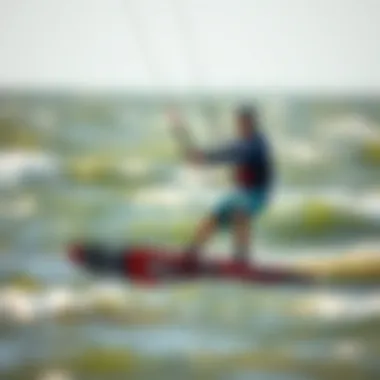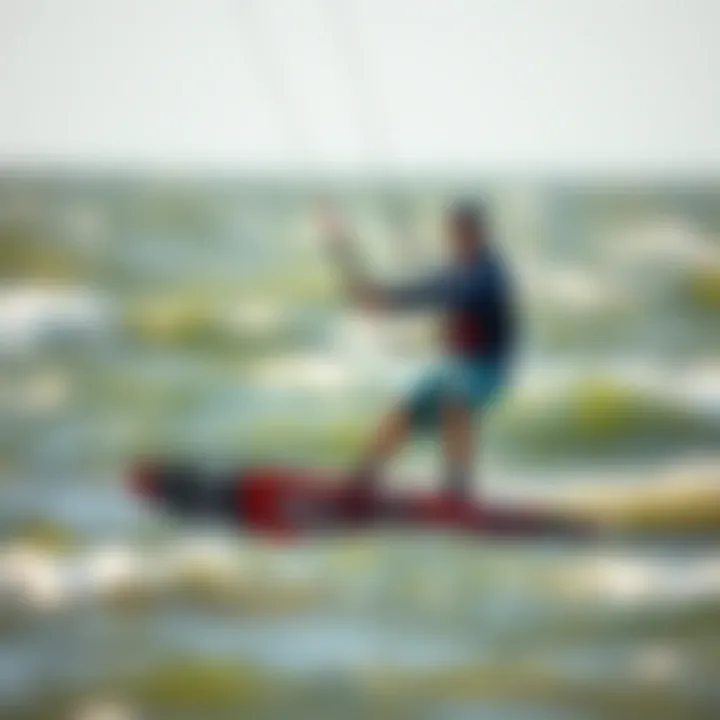Decoding the NJ Wind Speed Map for Kiteboarding


Intro
For kiteboarding enthusiasts, few things are more crucial than understanding the wind that carries them across the water. The NJ wind speed map acts like a compass, guiding kiteboarders to ideal spots even when conditions can be unpredictable. Knowledge of wind patterns, seasonal changes, and local geography can be a game-changer for those seeking an exhilarating experience on the waves.
Navigating the New Jersey coastline requires familiarity with several environmental factors, especially wind speeds. Simply put, kiteboarding without awareness of the wind is akin to sailing without a sail. Novices and seasoned riders alike can harness this vital resource to enhance their safety, performance, and overall enjoyment. Understanding how to interpret the wind speed map opens avenues for better choices in location and timing, allowing kiteboarders to ride the winds confidently.
The relationship between wind conditions and kiteboarding cannot be understated. A smooth ride can quickly turn into a challenging situation without proper awareness of what's happening in the atmosphere. So, let’s peel back the layers on the NJ wind speed map, taking a closer look at the gear, essential techniques, and practical tips that will pave the way for a more fulfilling kiteboarding adventure.
Prelude to Wind Speed Maps
In the world of kiteboarding, understanding how wind functions isn't just a perk; it’s a necessity. This is where wind speed maps come into play. They serve as the guideposts for enthusiasts, allowing them to interpret wind conditions accurately before they hit the water.
A wind speed map isn’t merely a chart showing gusts and breezes. Instead, it encapsulates a wealth of information tailored to the needs of kiteboarders. From pinpointing ideal launch sites to determining the best times to ride, these maps are a treasure trove of insights.
So, why should kiteboarders pay close attention to these maps? For starters, they provide immediate visibility on prevailing wind conditions. This information is crucial for ensuring not only an exhilarating experience but also a safe one. No one wants to find themselves navigating the waves when conditions suddenly shift!
One major benefit of wind speed maps is their ability to project wind patterns over time. They don’t just represent a snapshot of the current conditions; rather, they offer forecasts based on weather data. Being able to predict when and where the wind will blow helps at all levels of experience, from first-timers to seasoned veterans.
Furthermore, it’s essential to consider variations in wind speed based on geography. For instance, in a coastal environment like New Jersey, the wind can behave differently than in inland areas due to topographical influences.
Key Elements to Consider:
- Clarity: Not all maps display data the same way; ensure you're choosing one that is easy to read.
- Reliability: Check sources that update data regularly, ensuring accuracy. Websites like windy.com or noaa.gov are highly regarded.
- Detail Orientation: Look for features that provide detailed insights on direction and patterns in wind speed, making navigation less of a gamble.
Ultimately, a comprehensive understanding of wind speed maps can help maximize your kiteboarding experience. Think of it as your road map for the windy terrains of New Jersey; the better you read it, the more enjoyable your adventure will be on the water.
"Wind is a kiteboarder's best friend. To make the most of it, one must know how to read the signals it sends."
By delving into the specifics of wind speed maps, kiteboarders set themselves up for safer, more rewarding sessions. With knowledge comes confidence, and with confidence, the joy of navigating the wind with skill and finesse.
Importance of Wind in Kiteboarding
Kiteboarding isn’t just about the thrill of gliding over water and the rush of wind in your face; it’s intricately tied to understanding wind. For those who engage in this exhilarating sport, the wind serves as both friend and foe. A solid grasp of wind mechanics can significantly enhance performance, safety, and enjoyment on the water.
There are numerous elements involved in kiteboarding that pivot around wind. First and foremost, kiteboarders must realize that wind conditions determine the feasibility of any session. Too little wind can leave enthusiasts floundering while too much can lead to dangerous situations. Therefore, having a fundamental understanding of wind patterns is vital for both beginners and seasoned kiters.
The Role of Wind Conditions
Wind direction and strength are critical factors. If the wind is blowing onshore, it might create a safe environment for launching and landing. Conversely, offshore winds can push you further out to sea, which can turn a relaxing day into a precarious situation. Experienced kiteboarders often check local wind forecasts, but it’s also advantageous to observe conditions in real-time. Much like a fisherman reading the current, kiteboarders will scan the horizon for signs of changing conditions.
Another point worth noting is how wind conditions can vary significantly by location. For example, coastal areas may experience sudden gusts due to geographic features, while inland areas might have more consistent but often milder breeze. Understanding these variations allows kiteboarders to select more strategic spots for their sessions, enhancing both safety and enjoyment.
Wind Velocity and Kite Performance
Wind velocity can make or break a kiteboarding experience. Every kite has an optimal wind range in which it operates best. When the speed of the wind is too low, the kite struggles to generate lift, and you barely get off the water; too high, and it can feel like riding a wild bull. It’s essential to consult your kite’s specifications and match it with the day’s wind conditions.
To illustrate, consider the difference between using a large kite in moderate winds versus a smaller kite in high winds. The larger kite will harness the lighter air, allowing you to dance on the waves; however, in high winds, that same kite may become difficult to control, potentially leading to crashes or accidents.
Conversely, a smaller kite offers precision in turbulent winds, giving a rider the advantage of agility yet requires a higher skill level to master. This balance can be tricky; it’s much like driving a car in different weather conditions: you need to adjust your approach based on the environment.
“Understanding the wind not only elevates your skills but also enhances safety on the water. A well-prepared kiteboarder is always one step ahead.”
Wind is an ever-changing partner in kiteboarding. Familiarizing ourselves with how it behaves in different environments and conditions can make a significant difference in our experience. By grasping the nuances of the wind role and its effects on kite performance, kiteboarders empower themselves to make informed decisions on the water, ultimately amplifying their passion for the sport.
Decoding the NJ Wind Speed Map


Understanding the NJ Wind Speed Map is more than a casual endeavor for kiteboarding enthusiasts; it creates a bridge between abstract data and real-world performance. The wind can make or break a session of kiteboarding, so decoding the map allows you to grasp the finer nuances of wind behavior in New Jersey. This section pulls back the curtain on the map's features and sheds light on how to interpret the various markings and measurements. It’s an essential skill, particularly for those wanting to maximize their time on the water while ensuring safety.
Map Features and Symbols
When you first glance at the wind speed map, it may look like a jumble of colors, lines, and other symbols. However, each element conveys critical information. Here’s a breakdown of what to look out for:
- Color Codes: Often, wind speed maps employ a gradient scale. For instance, lighter shades might indicate calmer winds, while darker shades represent stronger gusts. Familiarizing yourself with these colors is your first step to decoding what you see.
- Wind Direction Arrows: These point in the direction the wind is blowing from, rather than where it is going. This can be crucial for your kiteboarding strategy; understanding this can help you anticipate whether you'll be facing headwinds or tailwinds.
- Scale Indicators: Look for a key on the map that matches color to wind speed in miles per hour or knots. Some maps might also integrate real-time data, giving you the latest wind updates, rather than relying on forecasts.
Remember, these features are not just there for ornamentation; comprehending them is vital for safety as well as performance on the water. Noteworthy, a well-interpreted map can enhance your kiteboarding experience considerably.
Understanding Wind Speed Measurements
Now, let's break down wind speed measurements themselves, a core component for understanding the NJ Wind Speed Map. Wind measurements are typically expressed in either knots or miles per hour. Here are some points to keep in mind:
- Knots vs. Miles Per Hour: Knowing how to convert between these measurements can save headaches. For example, 10 knots equates to about 11.5 miles per hour. Many kiteboarders prefer knots as it aligns with nautical terms commonly used in marine contexts.
- Gusts vs. Sustained Wind: It’s also essential to distinguish between gusts and sustained wind speeds. Sustained winds refer to continuous wind speed over a specified period, while gusts are short bursts. A 15 knot gust may look enticing on a calm day, but sustained winds below 10 knots can lead to a frustrating session.
- Ideal Wind Range: For kiteboarding, an ideal wind range usually falls between 12 and 25 knots depending on your skill level and kite size. Understanding these nuances will guide you in making an informed decision before hitting the water.
"Good wind conditions can take your kiteboarding experience from drab to fab in an instant."
By taking time to understand these wind speed measurements, you're not just reading a map; you're equipping yourself with the knowledge to make safer, more calculated decisions, allowing for a more enjoyable and successful kiteboarding session.
Factors Influencing Wind Patterns
Understanding the forces that sculpt local wind patterns is integral for kiteboarding enthusiasts. Winds are not simply products of chance; myriad factors interplay to create the currents that kiteboarders so deeply rely on. A nuanced understanding here not only enhances one’s kiteboarding experience but can greatly influence performance and safety on the water. Recognizing elements such as topography, coastal features, and seasonal changes gives kiteboarders an edge in selecting optimal conditions for their activities.
Topography and Coastal Features
New Jersey's unique geographical layout plays a significant role in determining wind patterns. The state showcases a mix of coastal plains, hills, and urban development, each contributing differently.
- Elevation Changes: Places like the Appalachian foothills impact wind intensity. Higher elevations can cause the wind to accelerate as it descends, while valleys might trap winds, creating less favorable conditions for kiteboarding.
- Water Bodies: Proximity to the Atlantic Ocean is vital. The ocean often brings steadier and stronger winds compared to inland areas. Beaches like Cape May and Island Beach State Park benefit from oceanic breezes, providing kiteboarders with reliable conditions.
- Obstructions: Urban structures, sand dunes, and vegetation can disrupt wind flow. For example, kiteboarding too close to large buildings can lead to unpredictable gusts, which can be dangerous. Understanding where these obstructions are in relation to popular kiteboarding spots will aid in making wise decisions regarding location.
Seasonal Wind Variations in NJ
Each season in New Jersey tells its own story through wind patterns. For kiteboarders, adapting to these changes is crucial.
- Spring: As winter recedes, winds tend to ramp up, particularly in March and April. This is a transitional time when northwesterly winds bring cooler air while spring storms can create gusty conditions. Kiteboarders should be prepared for variability, making this season both a challenge and an opportunity.
- Summer: The summer months bring warm, steady breezes, often from offshore. These conditions are ideal, but kiteboarders must also watch for increased thermal activities, which can lead to sudden shifts in wind direction, particularly in July and August. Popular spots during summer include Sandy Hook and Long Beach Island, where kiteboarders can enjoy both favorable winds and social gatherings.
- Fall: Autumn returns strong winds, often with greater consistency as storms begin to yield gustier days. This is the season when the ocean remains warm while the air cools, creating fantastic conditions for enthusiastic kiteboarders. Locations like Barnegat Light come alive with activity.
- Winter: Winter presents a different set of challenges. Wind speeds can be robust, but the cold can deter many. Kiteboarders who braved the chill find the winds less crowded and often more consistent. Hills and other variations in topography can channel winds here in ways that might not be evident in warmer months.
In summary, wind patterns driven by local topography and seasonal variations create a complex but predictable landscape for kiteboarding in New Jersey. Recognizing these factors equips enthusiasts to better anticipate conditions, enhancing safety and boosting performance while gliding over the water. By honing in on these intricacies, kiteboarders can navigate their adventures with more foresight and skill.
Utilizing Wind Speed Data for Kiteboarding
Wind speed data is not just numbers on a map; it’s the backbone of successful kiteboarding sessions along the New Jersey coastline. For kiteboarders, understanding this data can genuinely make or break an outing on the water. Knowing exactly how to read and use wind speed info not only enhances performance but also significantly increases safety measures. In this section, we’ll unpack the essentials of utilizing wind speed data effectively.
Selecting Optimal Kiteboarding Locations
Finding the right spot to launch your kite is mission critical. The wind speed data can be your scouting buddy, helping you identify the best areas based on specific conditions. Here are some points to consider:
- Local Knowledge: Popular locations like Sandy Hook and Long Beach Island often have established wind patterns. Leveraging the wind maps can help you decide if these places are suitable at a particular time.
- Geographical Features: Some locations might provide shelter from strong gusts thanks to nearby trees or buildings. Using wind speed maps allows you to gauge if such features are beneficial at your spot.
- Wind Direction: Input from the wind speed map's directionality can mean the difference between a thrilling ride and a rough session. Certain locations perform better with specific wind directions.
By assigning weight to these factors using wind speed data, kiteboarders can ensure they don’t find themselves stuck in a less-than-ideal situation.
Planning Sessions Around Wind Patterns
Real success in kiteboarding hinges on planning sessions that align with anticipated wind patterns. Here's how to do just that:
- Daily and Seasonal Trends: There’s more to wind than what meets the eye. Wind speed charts help you observe day-to-day and seasonal changes. If you notice a consistent rise in wind speeds during afternoons, aim for those times to get out on the water.
- Weather Forecasts: Combine wind maps with weather resources for a fuller picture. Websites like weather.com provide forecasts that can indicate when wind speeds might peak.
- Long-Term Patterns: Familiarizing yourself with the overarching wind trends for New Jersey can help you plan your kiteboarding calendar. For example, spring often brings more consistent wind conditions than the summer, making it a prime time for enthusiasts.


The winds in New Jersey are like a fickle friend – they can be on your side one minute and leave you high and dry the next. Understanding these patterns gives you an edge.
In summary, effectively utilizing wind speed data empowers kiteboarders to maximize their sessions, enhance their skills, and ensure they enjoy every moment on the water. It’s all about using the right tools to make informed decisions.
Safety Considerations When Kiteboarding
Safety can’t be an afterthought when you’re out on the wind-kissed waters of New Jersey. It’s not just about the thrill of kiteboarding, but also about knowing the lay of the land—the wind, the tides, the equipment, and most importantly, yourself. This section highlights the essential safety practices that kiteboarders should embrace to ensure a rewarding experience while minimizing any risks.
Assessing Wind Conditions Pre-Session
Before you even think about launching your kite, it’s crucial to assess wind conditions. Rushing into a session without checking the winds can lead to unpredictable situations. Here are some key factors to consider:
- Wind Speed: Know the ideal wind speed for your specific type of kite. If you find yourself in conditions that are far above or below this range, it may be wise to rethink your session.
- Wind Direction: Understanding how wind direction can affect your ride is vital. North winds might differ dramatically from a south breeze, especially along New Jersey’s complex coastline. Also, consider potential obstacles like trees or buildings that could create wind shadows or turbulence.
- Local Forecasts: Always check local weather forecasts and updates. Apps or websites designed specifically for kiteboarders can provide real-time information on wind conditions. This is not the day to trust your feelings; it’s the day to trust the data.
Reading signals in the environment is part of kiteboarding. Look at the trees, flags, and water ripples. If everything seems calm, it’s better to take a moment rather than risk inadequate assessments.
Emergency Protocols for Adverse Winds
Things can change faster than a cat can lick its ear out there. Wind conditions that seemed perfect may suddenly take a spunky turn. This is where understanding emergency protocols comes into play. Here’s how to prepare for unexpected adverse winds:
- Predefined Signals: Make sure you and your fellow kiteboarders have a set of signals for emergencies. A shout or gesture could mean there’s a significant wind shift. Establishing these signals can save lives—or at least make sure everyone is on the same page.
- Kite Safety Systems: Familiarize yourself with your kite’s safety systems. Whether it’s a quick-release mechanism or a leash, knowing how to use these can mean the difference between a near miss and a serious mishap.
- Escape Plans: Always have a plan for getting back to the beach. Know the currents and tides, so you can navigate your way back if conditions become tricky. Identify landmarks you can aim for in a pinch.
"Preparation is key; it’s like having a safety net in a high-stakes show. You might not need it every time, but when you do, it’s a life-saver."
- Buddy System: Don’t go it solo. Kiteboarding with a buddy is not just good for socializing; it also adds an extra layer of safety. If one of you gets into trouble, the other can lend a hand.
By keeping safety at the forefront, kiteboarding can be both an exhilarating and rewarding experience. An understanding of wind patterns, alongside vigilance and preparedness, can transform potential hazards into mere bumps on an otherwise smooth ride.
Advanced Techniques for Wind Management
Managing wind effectively stands at the foundation of successful kiteboarding. For enthusiasts looking to optimize their sessions and enhance safety on the water, mastering advanced techniques is essential. This section explores strategies for controlling your kite during variable wind conditions and leveraging wind data to gain an edge over competitors.
Kite Control in Variable Winds
When kiteboarding, the winds often don’t play by the rules. Experienced kiteboarders know that mastering kite control is not just about technique; it’s about adapting to changes in the wind. Variable winds can shift in intensity and direction unexpectedly.
Here are some key points to consider for better kite control:
- Foot Positioning: Adjusting your weight distribution is paramount. Leaning back may help to stabilize your board in strong gusts, while moving forward can assist in slicing through lighter winds.
- Kite Angles: Actively managing the angle of your kite in response to wind shifts can maximize lift. For instance, if the wind picks up, lowering the kite to maintain stability and control helps to avoid unnecessary crashes.
- Body Movements: Subtle body movements can greatly influence your performance. Shifting your weight side-to-side or leaning into turns not only keeps you balanced but also helps enhance kite responsiveness against the unpredictable gusts.
"Understanding how to adapt to the unpredictable nature of wind can be the difference between a perfect session and a struggle in the water."
Using Wind Data for Competitive Advantage
In today’s digital age, kiteboarders have access to extensive wind data thanks to advancements in meteorological mapping. For those looking to push their limits, the key lies in how you interpret and utilize this data.
- Scout Locations with Predictable Wind Patterns: Analyzing historical wind speed data can help you identify the best times and locations for kiteboarding. For instance, areas around Cape May might consistently show favorable conditions in late summer, perfect for catching those thermals.
- Real-Time Analysis: Utilizing apps like Windy or KiteBuddy that provide real-time wind conditions aids in making an informed decision right before hitting the water. Adjusting your plans based on live data enhances your experience.
- Participate in Online Communities: Engaging with forums on platforms such as Reddit can keep you updated on the latest trends and strategies shared by fellow kiteboarders. Many seasoned enthusiasts share insights based on their own experiences with specific wind maps and conditions.
Incorporating these elements into your kiteboarding routine not only boosts your skill but also enriches your entire experience on the water. Understanding varying wind conditions and leveraging wind data can ensure that you ride the waves with confidence and style.
Kiteboarding Destinations in New Jersey
Choosing the right destination for kiteboarding in New Jersey can make or break an experience out on the water. Not only does the location determine the wind consistency, but it also dictates the safety and overall enjoyment of your time. Kiteboarding is not just a sport; it's about finding that sweet spot where the elements align just right. Some areas in NJ are renowned for their ideal kiteboarding conditions, while others are slowly becoming popular among enthusiasts. It's essential to keep an eye on these popular spots and emerging areas to optimize your sessions.
Top Spots for Wind Consistency


When it comes to wind consistency, certain locations shine brighter than others. These spots are favored by kiteboarders for their reliable wind patterns and conditions.
- Sandy Hook: A long and narrow spit of land, Sandy Hook provides excellent east and southeast winds. The open water on the ocean side is perfect for larger kites, making it an ideal choice.
- Barnegat Bay: This area is quite popular for its steady winds that tend to blow well into the afternoon. The shallow waters are particularly safe for both beginners and advanced kiteboarders alike.
- Cape May: Known for its inviting seaside atmosphere, Cape May offers steady winds due to the coastal geography. The local kiteboarding community adds to the vibrant energy here.
- Long Beach Island: For those looking to combine vacation vibes with kitesurfing, Long Beach Island is a great option. Venturing here often rewards kiteboarders with consistent winds.
These areas not only present favorable wind conditions but also boast beautiful landscapes, local amenities, and a community eager to welcome fellow kiteboarding fans.
Emerging Kiteboarding Areas
While everyone knows about the established destinations, new spots are continually cropping up on the kiteboarding radar.
- The Inlet in Manasquan: A growing favorite among local kiteboarders, this area offers a mix of river and ocean winds that are conducive to great sessions, especially during the summer months.
- Atlantic City: Known more for its casinos than kiteboarding, Atlantic City is gaining traction among enthusiasts due to the swell in interest and consistent winds right off the boardwalk.
- Belmar: Another emerging destination, Belmar offers the charm of a small beach town combined with fantastic wind conditions, making it a great new spot for kiteboarding addicts.
It's always wise to stay updated about these emerging areas as they can provide new adventures and opportunities that seasoned kiteboarders might not want to miss!
Whether you're an experienced rider or new to the sport, understanding and exploring kiteboarding destinations in New Jersey is crucial for an enjoyable experience on the water. Insights into wind patterns and local spots can enhance overall kiteboarding enjoyment.
Future Trends in Wind Mapping Technology
In the ever-evolving world of kiteboarding, staying ahead of the game means understanding and leveraging the latest in wind mapping technology. For kiteboarders in New Jersey, the utility of wind speed maps is undeniable. However, as technology progresses, new trends emerge that can significantly enhance our experience on the water. By keeping an eye on these future trends, kiteboarding enthusiasts can make more informed decisions, ensuring both safety and performance are prioritized.
Advancements in Digital Mapping
Advancements in digital mapping technology have reshaped how we access and interpret wind data. Unlike traditional maps, which often provide static wind speed information, the modern digital landscape offers dynamic interfaces. This means that wind maps are now often equipped with up-to-the-minute data that can shift as weather patterns evolve.
- User-Friendly Interfaces: Many platforms have developed intuitive interfaces that make it easier for users to navigate and glean useful information. Icons and color codes representing wind speed and direction can provide immediate insight, even to novice kiteboarders.
- Mobile Applications: The rise of smartphone apps has revolutionized how enthusiasts check conditions on-the-go. Apps like Windy and Kitefinder give real-time updates, allowing users to quickly decide whether the conditions are suitable for kiteboarding.
- Integration of Satellite Data: With satellite technology providing more accurate geographic and meteorological information, kiteboarders can now access enhanced wind speed predictions. The use of this data helps refining predictive models which can gauge upcoming wind conditions and their effects on various kiteboarding locations in New Jersey.
Integrating Real-Time Data into Kiteboarding
The integration of real-time data into kiteboarding practices fundamentally alters how enthusiasts prepare for their sessions. Real-time data, gathered from local weather stations and advanced models, offers insights that can make or break a kiteboarding outing.
- Immediate Alerts: Systems that provide instantaneous wind condition alerts can be lifesavers. For kiteboarders planning a day on the water, knowing about sudden wind changes can mean the difference between a great session and a hazardous experience.
- Enhanced Decision Making: Kiteboarders can utilize live updates to adjust their plans based on changing conditions. For instance, if the wind is dying down at one spot, they can quickly check another location, making informed choices for the best kiteboarding experience.
- Community Sharing: Social networks and platforms enable riders to share real-time insights. A local kiteboarder can update conditions on Facebook or Reddit, creating a community of informed kite enthusiasts ready to take advantage of the finest moments to hit the water.
"Having access to real-time wind data is a game changer for kiteboarding. It empowers you to make smarter choices about where and when to ride."
The continuous evolution of wind mapping technology is not just about keeping pace with trends; it’s about enhancing the entire kiteboarding experience. For both seasoned and novice kiteboarders, adapting to these changes can lead to safer, more enjoyable sessions on the beautiful waters of New Jersey. So keep your eyes peeled—what's coming next in tech might just redefine your next adventure.
Culmination: Maximizing Kiteboarding Experience
Kiteboarding, at its core, is not just about riding the waves; it's an intricate dance with the wind. As highlighted throughout this article, the NJ wind speed map serves as the compass guiding enthusiasts through this thrilling sport. To maximize the kiteboarding experience, understanding the wind map is essential. It affects everything—from selecting location to timing sessions and ensuring safety on the water.
By grasping how to interpret the wind speed data, kiteboarders become more adept at identifying ideal conditions. This understanding empowers riders, elevating their skills and allowing them to push boundaries safely. The wind map should be viewed not merely as a tool but as a vital ally in every kiteboarder's arsenal.
"Knowledge is power, especially when it comes to harnessing nature's energy."
Recap of Wind Map Importance
The NJ wind speed map is a lifeline for anyone who partakes in kiteboarding. It provides crucial data, translating wind speeds into practical knowledge—knowledge that can impact both performance and safety. Fundamentals like:
- Understanding Wind Speeds: Each knot translates into a measurable response from your kite. Knowing this helps in making informed decisions about kite size and type.
- Identifying Patterns: Maps offer a glimpse into how wind behaves at specific times and locations, guiding kiteboarders toward optimal conditions.
- Enhancing Safety: Being aware of potential shifts in wind patterns allows for proactive adjustments to one’s kiteboarding plans.
Thus, the wind speed map is an indispensable resource, painting a broader picture that helps navigate New Jersey's breezy landscapes while ensuring enjoyment and safety.
Encouragement for Continued Learning
Kiteboarders—whether novices or seasoned—should view the journey as one of continual learning. The complexity of wind behavior may seem daunting at first, but like the sport itself, it's about persistence.
- Attend Workshops and Seminars: Local kiteboarding communities often organize learning sessions focusing on wind dynamics and safety protocols. Engaging in these spaces helps build camaraderie and offers deeper insights.
- Utilize Online Resources: Websites like Wikipedia or Britannica can offer fundamental knowledge that complements hands-on experience. Kiteboarding forums on platforms such as Reddit provide avenues for discussion and tips.
- Experiment and Reflect: Staying curious and trying out different locations lets you personally experience how wind affects your riding style.
This mindset fosters not just improvement, but a deeper appreciation for the sport and the natural elements involved.
In the end, kiteboarding is about mastering the wind and enjoying the ride. Embracing the learning process can lead to remarkable adventures on the breezy waters of New Jersey.



